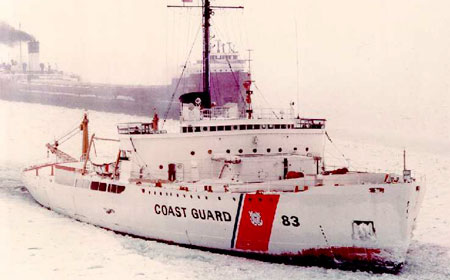
Builder: Toledo Shipbuilding Company (bankruptcy), American Shipbuilding and Drydock CompanyCommissioned: December 20, 1944Decommissioned: June 10, 2006Length: 290 feetBeam: 74.3 feetDisplacement: 5,336 tonsSpeed: 15 knots (17mph)Ice Capacity:
History: Mackinaw was built as part of the World War II effort to meet
the heavy demands on the increased production of war materials. Tremendous increases
in the movement of iron ore, limestone, and coal for the nation’s steel mills
was particularly necessary. In order to keep tonnage on the move during winter
months, icebreakers were needed. Congress authorized the construction of Mackinaw
on December 17, 1941, ten days after the attack on Pearl Harbor.
The Mackinaw was built specifically for Great Lakes use. She was
a “squashed down” Wind class vessel, with greater beam and length, but
shallower draft than those vessels. Her powerplant and general design were those
of the Wind Class, but her hull was of mild steel, for freshwater operations.
The Mackinaw was designed to extend the operating season in Great Lakes ports,
a strategically important task considering the essential raw materials originating
from the region: iron ore, coal, limestone, etc.
Cheboygan, Michigan remained her home port her entire life. Saved from
scrapping, Mackinaw now serves as a museum ship known as the Icebreaker Mackinaw
Maritime Museum, which you can visit in Mackinaw City, Michigan.
